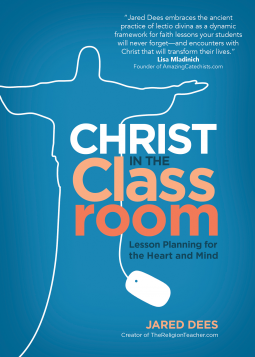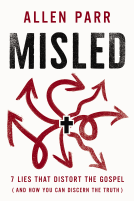
Christ in the Classroom
Lesson Planning for the Heart and Mind
by Jared Dees
This title was previously available on NetGalley and is now archived.
Send NetGalley books directly to your Kindle or Kindle app
1
To read on a Kindle or Kindle app, please add kindle@netgalley.com as an approved email address to receive files in your Amazon account. Click here for step-by-step instructions.
2
Also find your Kindle email address within your Amazon account, and enter it here.
Pub Date Sep 07 2018 | Archive Date Nov 02 2018
Talking about this book? Use #ChristInTheClassroom #NetGalley. More hashtag tips!
Description
If the goal of catechesis is to cultivate an encounter with Christ, why do religious educators spend so much time focused almost exclusively on ideas and not experiences? The reason is that many have never been shown a method that inspires the heart while also instructing the mind. Jared Dees, creator of the popular website The Religion Teacher, shows how applying the steps of lectio divina to teaching can reorient religious education toward encountering the person of Christ rather than merely sharing information about him.
In Christ in the Classroom, Catholic author and speaker Jared Dees applies the four steps of lectio divina—reading/learning, meditation, prayer, contemplation, and action—to the ministry of catechesis. He offers teachers and catechists a practical framework for preparing lessons that broaden the focus of teaching from mostly intellectual learning to also encountering Christ in prayer, reflection, and action. Using this method, students and catechists come to know intimately the person of Christ at the same time that they are learning the tenets and traditions of the Church.
Dees shares stories of success and failure from his own teaching experience and he offers dozens of field-tested strategies, tactics, and teaching methods to effectively integrate the steps of lectio divina into the classroom or other catechetical setting.
Outfitted with these tools, both experienced and new religious educators will feel confident in their ability to teach effectively and lead their students to a life-changing encounter with Jesus.
A Note From the Publisher
Advance Praise
“With this innovative and exciting new book, Jared Dees embraces the ancient practice of lectio divina as a dynamic framework for faith lessons your students will never forget—and encounters with Christ that will transform their lives.”
Lisa Mladinich
Founder of AmazingCatechists.com
"Jared Dees is the encouraging mentor every catechist and religion teacher needs. In Christ in the Classroom, we discover ways to not only assist students in learning more about Christ but, more significantly, to also provide frequent opportunities to lead students to him."
Pat Gohn
Editor of Catechist and author of All In
“As a director of religious education for the last forty-five years, I am absolutely convinced that Jared Dees is spot on with this approach.”
Peggy Pigors
Coordinator of Adult Faith Formation at St. Clare Parish
Santa Clarita, California
“Lectio divina lesson planning is an awesome catechetical method. Since I teach every day, I cannot thank you enough for this priceless approach.”
Gerri Jose
Master Catechist at St. Elizabeth Parish
San Francisco, California
Available Editions
| EDITION | Paperback |
| ISBN | 9781594718618 |
| PRICE | $12.95 (USD) |
Featured Reviews
A good guide for Sunday school teachers filled with helpful advice and tips on what not to do within the first few pages, it helps you optimise your lessons for all ages - perfect if you teach either a wide age range or a small bracket.
 Ruth C, Reviewer
Ruth C, Reviewer
I found Christ in the Classroom when perusing NetGalley one day and decided to give it a try. It is Jared Dees' thesis that unless our students develop a relationship with Christ, we are wasting our time. I tend to agree. While I understand why religion texts seem to have gotten longer and more complex over the years, it seems to me, especially when working with basically unchurched kids, that all we are doing is (attempting to)filling their heads with trivia. If you have no relationship with Jesus are you going to attend Mass? If you don't attend Mass, does it matter if you can define transubstantiation or epiclesis?
Dees advocates integrating real times of prayer into your class and the form of prayer he advocates is Lectio Divina, basically praying with scripture.
Regarding those overly wordy textbooks, Dees recommends picking a limited number of points to make and rather than trying to cover the whole chapter, make those points in a variety of ways--and then use them as a basis for prayer.
The book itself is easy to read and would be a good gift for any new catechist and well as for experienced ones who are open to trying something new.
Dees is the author of the website The Religion Teacher which has both free and paid resources.
I'd like to thank Dees and the publisher for making a review copy available via NetGalley. Grade: B+
 Elizabeth O, Reviewer
Elizabeth O, Reviewer
Catholic school principals, dioceses, Directors of Religious Education, team leads in Catholic schools, and anyone who wants to be an effective catechist, listen up: you need to read this book. And if you are a leader in your parish or school with teachers or volunteers who teach kiddos, you need to buy a copy of this for every one of them.
As a teacher, I can confidently share that Jared Dees has compiled current research on pedagogy in a succinct manner and applied it to the religious education classroom. Is teaching the Faith about knowing the answers to pop quiz questions? The author says it is not and all of us should agree. But how do we accomplish bringing our students to learn to love God rather than just know about Him? This book breaks down an encompassing method: apply Lectio Divina to your lesson planning.
Dees doesn't just mean that you should be preparing your lessons through prayerful consideration and meditation, but he actually creates a structure for the lesson that follows the four steps of Lecito Divina (he adds one more), corresponding to the chapters. He encourages teachers to be the "guide on the side" instead of simply lecturing and to engage students through those Lectio Divina steps: reading, meditating, praying, contemplating, and acting. Dees concludes that this structure is not meant to be a template (probably so a teacher who has been teaching for years doesn't throw their hands up in frustration that they're supposed to change everything they're doing), but that the teacher can just apply the principles to what he or she is already doing. Personally, if a teacher aims to lead his or her students to Christ, rather than just to answering the questions right, they would follow his structure (and abundant tips, resources, examples, and suggestions!) to a T.
Many parishes and Catholic schools hire good people who have never taught before or who need a refresher on the best way to teach (read: don't just lecture all day). This book, if read and discussed in a staff-wide book club, could be a linchpin. It teaches pedagogy for all education philosophy, reflects on the importance of leading students to encounter Christ, and provides specific and concrete resources that teachers can take and use in tomorrow's lesson plans. Highly recommended.
 Mechthild R, Educator
Mechthild R, Educator
An interesting book for Christian educators
Jared Dess is the creator of the website "The Religious Teacher" that offers free and paid resources. He is also engaged in a variety of Catholic ministries and author of books and articles. His book "Christ in the Classroom - Lesson Planning for the Heart and Mind" is primarily written for Catholic educators and catechists, some of the concepts can also be applied by educators from different Christian backgrounds (Evangelicals, Lutherans, ...). It is good fro people who have no background in pedagogy. Dees shows the mistakes that are made by educators: long lectures, limited class engagement, lack of relevance for students. Instead, in his opinion, there should be worksheets and resources that challenge the students and help them to make connections to their daily life. Dees encourages to guide the students and shows how to engage them by applying the four steps of the Lectio Divina: reading, meditating, praying, contemplating. As a final steps he adds the step of acting because he is convinced that the natural effect of an encounter with Christ is action and that the students "start to see how they are being called to think and act differently. They start to see how they must live their lives in new ways."
Not being Catholic, it was an interesting book to read and I recommend the book for Christian educators of various traditions who have an open mind and are looking for new ideas for their teaching (and some of the ideas can even be applied in other subjects where a Christian world view can also be applied).
The complimentary copy of this book was provided by the publisher through NetGalley free of charge. I was under no obligation to offer a positive review. Opinions expressed in this review are completely my own.
#ChristInTheClassroom #NetGalley













